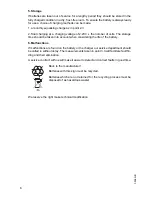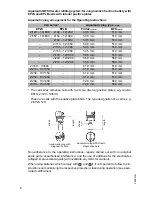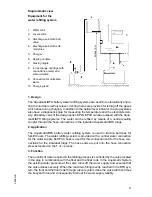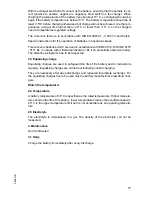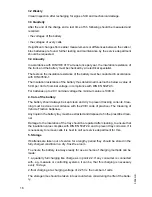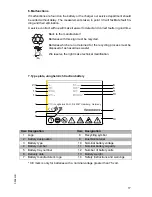
3
0506
.GB
Ignoring the operation instructions, repair with non-original parts or using additives for
the electrolyte will render the warranty void.
For batteries in classes
I and
II the instructions for maintaining the appropriate
protection class during operation must be complied with (see relevant certificate).
1. Commissioning filled and charged batteries. For commissioning of unfilled
batteries see separate instructions!
The battery should be inspected to ensure it is in perfect physical condition.
The charger cables must be connected to ensure a good contact, taking care that the
polarity is correct. Otherwise battery, vehicle or charger could be damaged.
The specified torque loading for the polscrews of the charger cables and connectors
are
:
The level of the electrolyte must be checked. If it is below the antisurge baffle or the
top of the separator it must first be topped up to this height with purified water.
The battery is then charged as in item 2.2.
The electrolyte should be topped up to the specified level with purified water.
2. Operation
DIN EN 50272-3 «Traction batteries for industrial trucks» is the standard which ap-
plies to the operation traction batteries in industrial trucks.
2.1 Discharging
Be sure that all breather holes are not sealed or covered.
Electrical connections (e.g. plugs) must only be made or broken in the open circuit
condition.
To achieve the optimum life for the battery, operating discharges of more than 80%
of the rated capacity should be avoided (deep discharge).
This corresponds to an electrolyte specific gravity of 1.13 kg/l at the end of the di-
scharge. Discharged batteries must be recharged immediately and must not be left
discharged. This also applies to partially discharged batteries.
2.2 Charging
Only direct current must be used for charging. All charging procedures in accordance
with DIN 41773 and DIN 41774 are permitted. Only connect the battery assigned to
a charger, suitable for the size of battery, in order to avoid overloading of the electric
cables and contacts, unacceptable gassing and the escape of electrolyte from the
cells.
In the gassing stage the current limits given in DIN EN 50272-3 must not be excee-
ded. If the charger was not purchased together with the battery it is best to have its
suitability checked by the manufacturers service department. When charging, proper
provision must be made for venting of the charging gases.
steel
M 10
23 ± 1 Nm
3
0506
.GB
Ignoring the operation instructions, repair with non-original parts or using additives for
the electrolyte will render the warranty void.
For batteries in classes
I and
II the instructions for maintaining the appropriate
protection class during operation must be complied with (see relevant certificate).
1. Commissioning filled and charged batteries. For commissioning of unfilled
batteries see separate instructions!
The battery should be inspected to ensure it is in perfect physical condition.
The charger cables must be connected to ensure a good contact, taking care that the
polarity is correct. Otherwise battery, vehicle or charger could be damaged.
The specified torque loading for the polscrews of the charger cables and connectors
are
:
The level of the electrolyte must be checked. If it is below the antisurge baffle or the
top of the separator it must first be topped up to this height with purified water.
The battery is then charged as in item 2.2.
The electrolyte should be topped up to the specified level with purified water.
2. Operation
DIN EN 50272-3 «Traction batteries for industrial trucks» is the standard which ap-
plies to the operation traction batteries in industrial trucks.
2.1 Discharging
Be sure that all breather holes are not sealed or covered.
Electrical connections (e.g. plugs) must only be made or broken in the open circuit
condition.
To achieve the optimum life for the battery, operating discharges of more than 80%
of the rated capacity should be avoided (deep discharge).
This corresponds to an electrolyte specific gravity of 1.13 kg/l at the end of the di-
scharge. Discharged batteries must be recharged immediately and must not be left
discharged. This also applies to partially discharged batteries.
2.2 Charging
Only direct current must be used for charging. All charging procedures in accordance
with DIN 41773 and DIN 41774 are permitted. Only connect the battery assigned to
a charger, suitable for the size of battery, in order to avoid overloading of the electric
cables and contacts, unacceptable gassing and the escape of electrolyte from the
cells.
In the gassing stage the current limits given in DIN EN 50272-3 must not be excee-
ded. If the charger was not purchased together with the battery it is best to have its
suitability checked by the manufacturers service department. When charging, proper
provision must be made for venting of the charging gases.
steel
M 10
23 ± 1 Nm
Summary of Contents for EJC M10
Page 1: ...Operating instructions 51145321 EJC M10 G 05 09 05 09...
Page 3: ...0108 GB...
Page 7: ...0506 GB 2...
Page 9: ...1004 GB A 2...
Page 13: ...0509 GB B 4 h1 h14 h2 h3 h4 l1 l l2 h13 m2 y c Q b5 Ast W a B s...
Page 17: ...0509 GB B 8...
Page 21: ...0509 GB C 4...
Page 29: ...0509 GB D 8...
Page 32: ...E 3 0509 GB 2 1 11 3 4 5 7 6 6 8 9 10 7 6 6 8 9 10 8 9 t o...
Page 73: ...0506 GB 18...


















